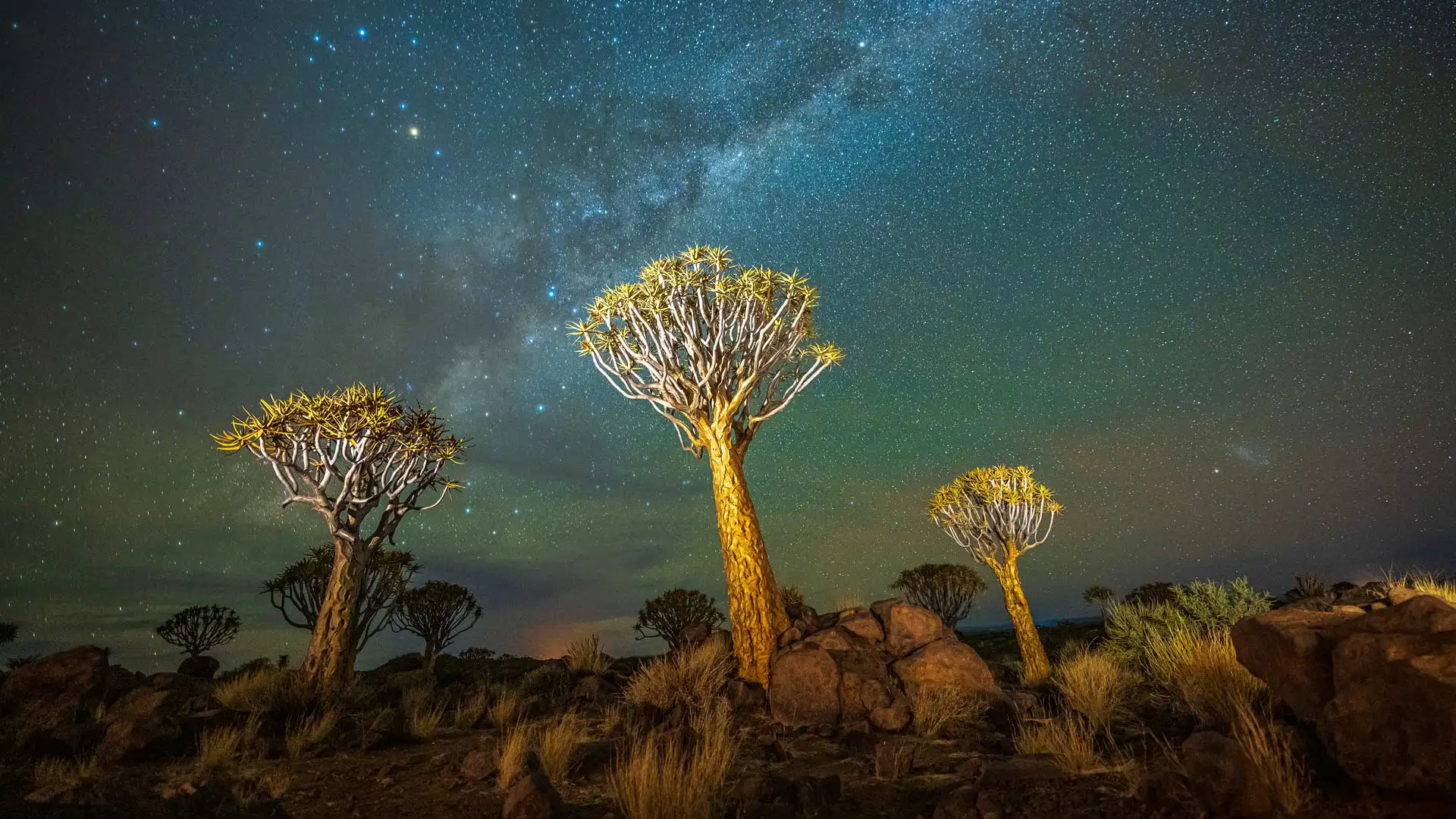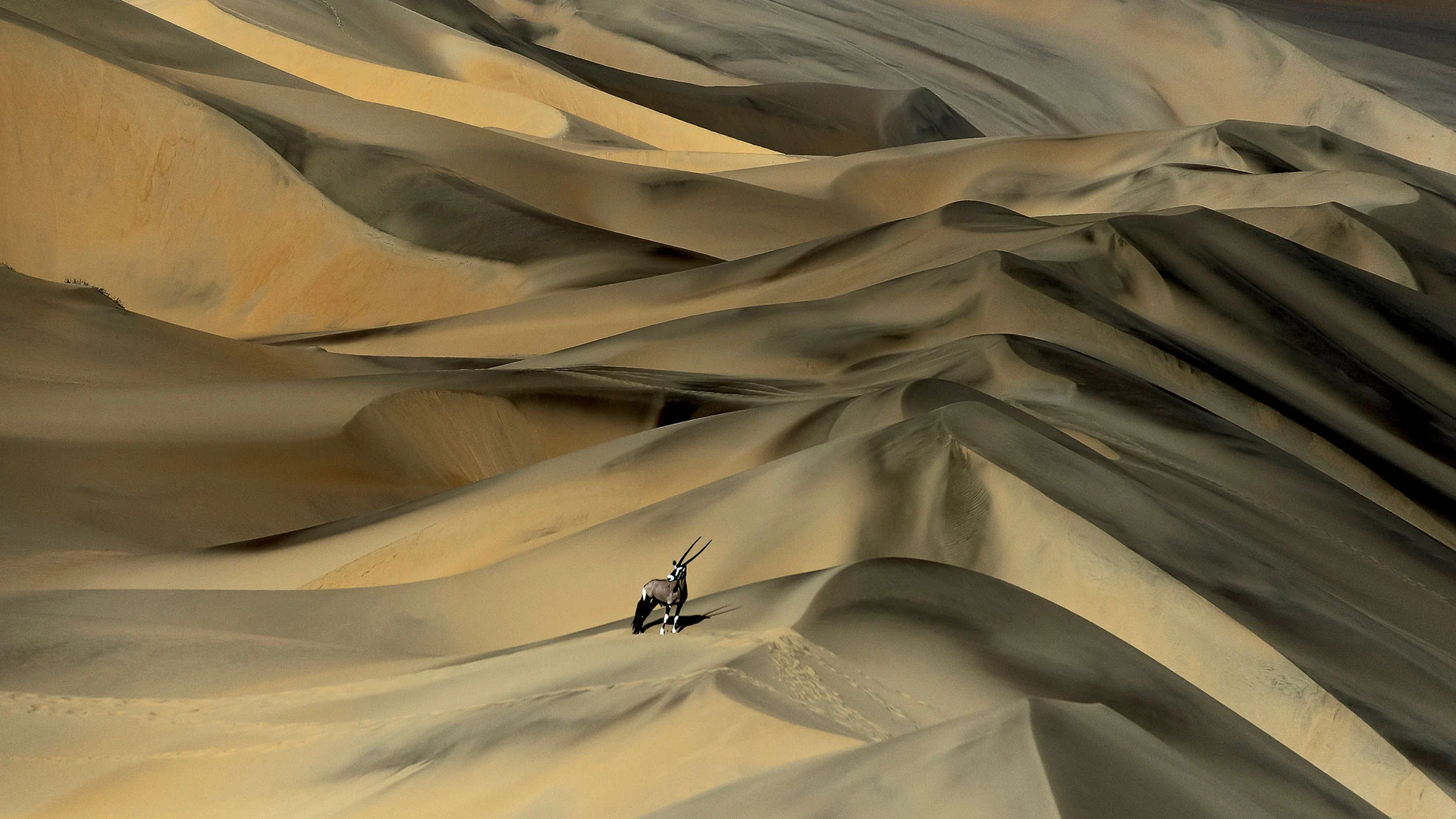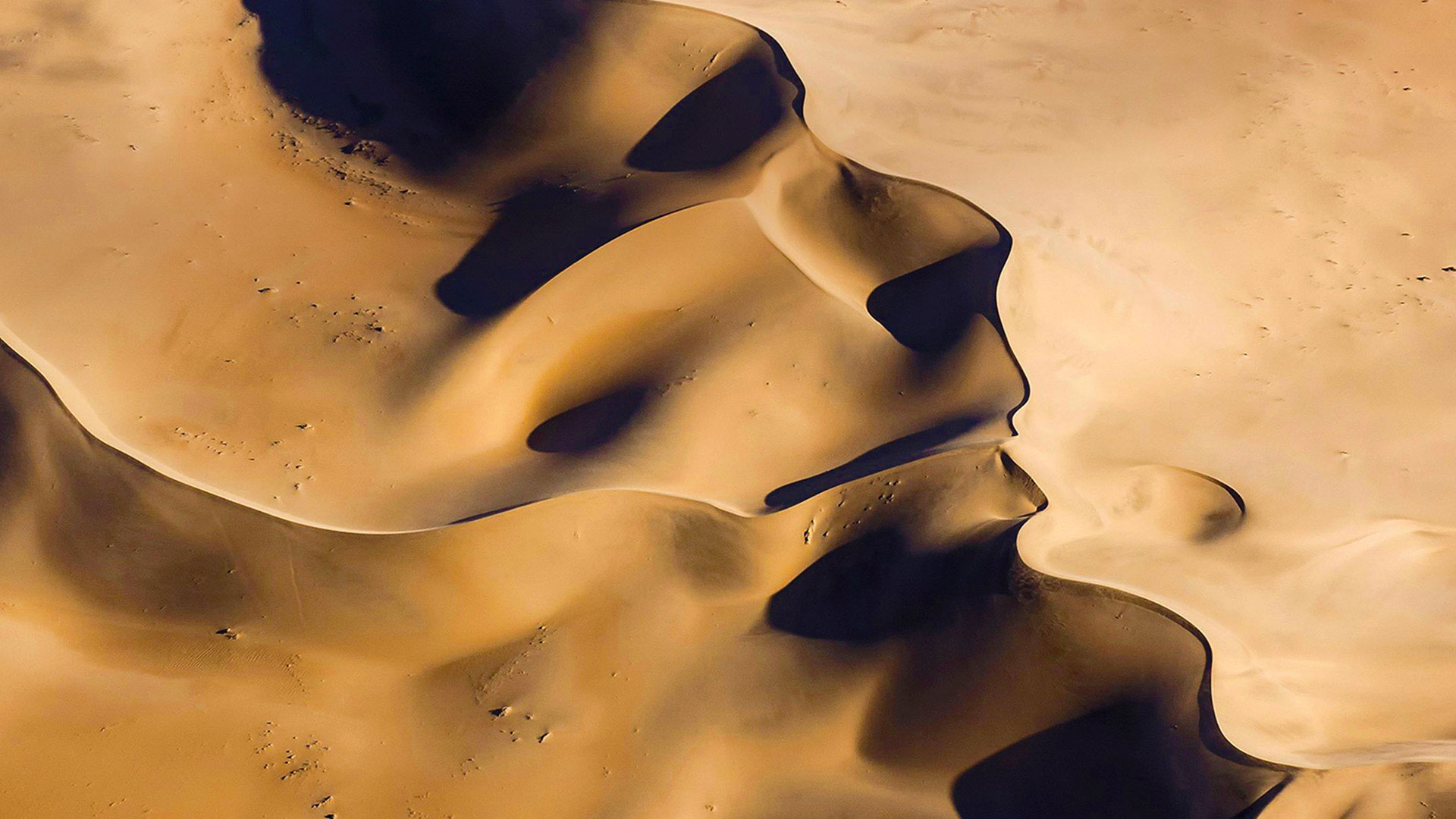夜晚的箭袋树与银河,基特曼斯胡普,纳米比亚 Quiver trees under the Milky Way, Keetmanshoop, Namibia (© Wim van den Heever/naturepl.com)
夜晚的箭袋树与银河,基特曼斯胡普,纳米比亚 Quiver trees under the Milky Way, Keetmanshoop, Namibia (© Wim van den Heever/naturepl.com)
星光下的颤动之树 Quivering under starlight
箭袋树,基特曼斯胡普,纳米比亚
在地球上所有的植物中,箭袋树或许最像来自未来的生命。它们分布于非洲南部,尤其是纳米比亚的干旱地区。虽然名字里有“树”,但它其实是一种芦荟属植物,经过漫长岁月的适应,能在炙热的沙漠中顽强生存。厚实的树干储存水分,分枝则能反射热量,帮助它抵御极端环境。箭袋树可高达7米,有的寿命超过百年,是沙漠生态系统中不可或缺的一环。在几乎没有其他树木的荒原上,它为鸟类提供了珍贵的栖息与筑巢之所。
“箭袋”这一名称正源于当地桑人的古老习俗,他们曾将树枝挖空制作箭袋。位于基特曼斯胡普附近的箭袋树森林如今被列为纳米比亚国家纪念地,也是该国最受摄影师喜爱的景点之一。这片沙漠拥有地球上最清澈的夜空,是观星的绝佳之地。在今日图片中,箭袋树的轮廓映衬在银河之下,仿佛在星光中轻轻颤动。尽管气候变化正在改变它们的自然分布范围,这些树依然是纳米比亚粗犷之美的象征,提醒着我们,大自然总能以最富想象力的方式适应与延续。
Quiver trees, Keetmanshoop, Namibia
Of all the plants on Earth, the quiver tree looks the most like a vision from the future. Found in Southern Africa, including parts of Namibia, these striking giants are not true trees but a species of aloe adapted to life under the desert's scorching sun. Their thick trunks store water, while their branches reflect heat, helping them endure harsh conditions. Reaching up to 23 feet in height, with some living for more than 100 years, quiver trees are also vital to their ecosystem. They offer rare perches and nesting sites for birds in landscapes where few other trees exist.
The name 'quiver' comes from the Indigenous San people, who once hollowed out the branches to craft lightweight arrow holders, or quivers. The Quiver Tree Forest near Keetmanshoop is a national monument and one of Namibia's most photographed sites. With some of the clearest skies on Earth, the desert provides a perfect backdrop for stargazing. In today's image, quiver trees stand silhouetted against the Milky Way. Though climate shifts are altering their natural range, these trees remain a symbol of Namibia's rugged beauty—and a reminder of how nature adapts in the most imaginative ways.
苏丝斯黎沙丘,纳米布沙漠,纳米比亚 Sossusvlei sand dunes, Namib Desert, Namibia (© Airpano/Amazing Aerial Agency)
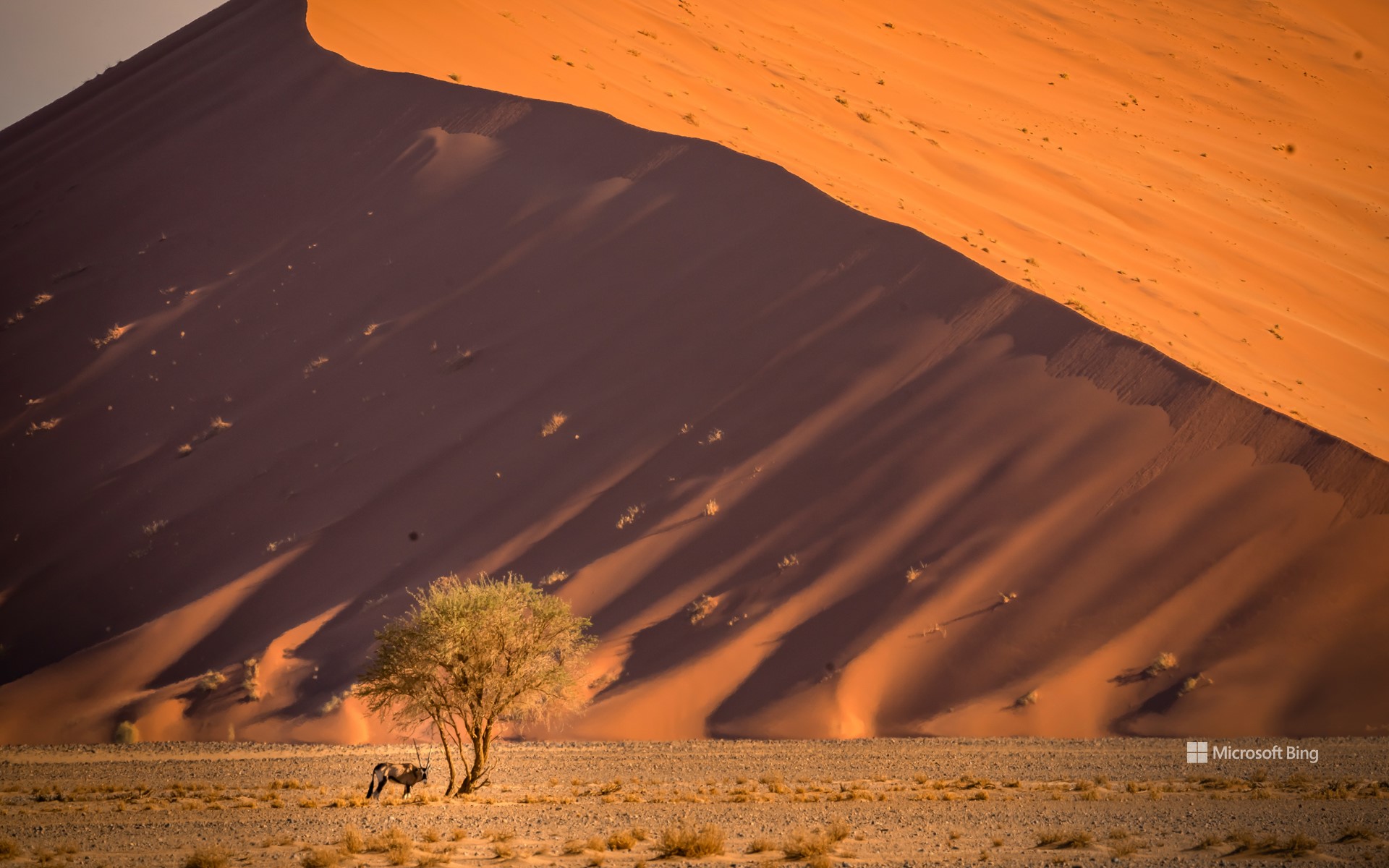
苏丝斯黎沙丘,纳米布沙漠,纳米比亚 Sossusvlei sand dunes, Namib Desert, Namibia (© Airpano/Amazing Aerial Agency)
变换的地平线 Shifting horizons
苏丝斯黎沙丘,纳米布沙漠,纳米比亚
想象在日出时分,连绵起伏的沙丘泛着橙色光芒,延伸至视野尽头,欢迎来到横跨纳米比亚数千英里的纳米布沙漠。据估计它已有5500万年的历史,被认为是世界上最古老的沙漠。这里拥有地球上最著名的沙丘,包括高达1,066英尺的“大爸爸”沙丘;纳米比亚最高的沙丘“沙丘7”,高度达1256英尺;以及深受摄影师喜爱的“沙丘45”,高度约为560英尺。
在这片广袤干旱的沙漠中心,是苏丝斯黎,也就是今天图片中的场景。这里是一片被高耸沙丘环绕的盐沼和黏土平原,讲述了一个对比的故事。大约每十年,曹查布河泛滥时,这片平原会化作令人惊叹的碧蓝湖泊。附近的‘死亡谷’令人毛骨悚然,这里有古老干枯的骆驼刺树,由于极度干燥的气候,它们未曾腐烂,仿佛被时间冻结。游客还能在此目睹一个充满惊人生命力的生态系统。从适应力极强的剑羚到聪明的纳米布沙漠甲虫,后者通过背部收集雾滴饮用水,这片沙漠充满了生存与韧性的故事。
鱼河大峡谷,纳米比亚 Fish River Canyon, Namibia (© R. M. Nunes/Getty Images)
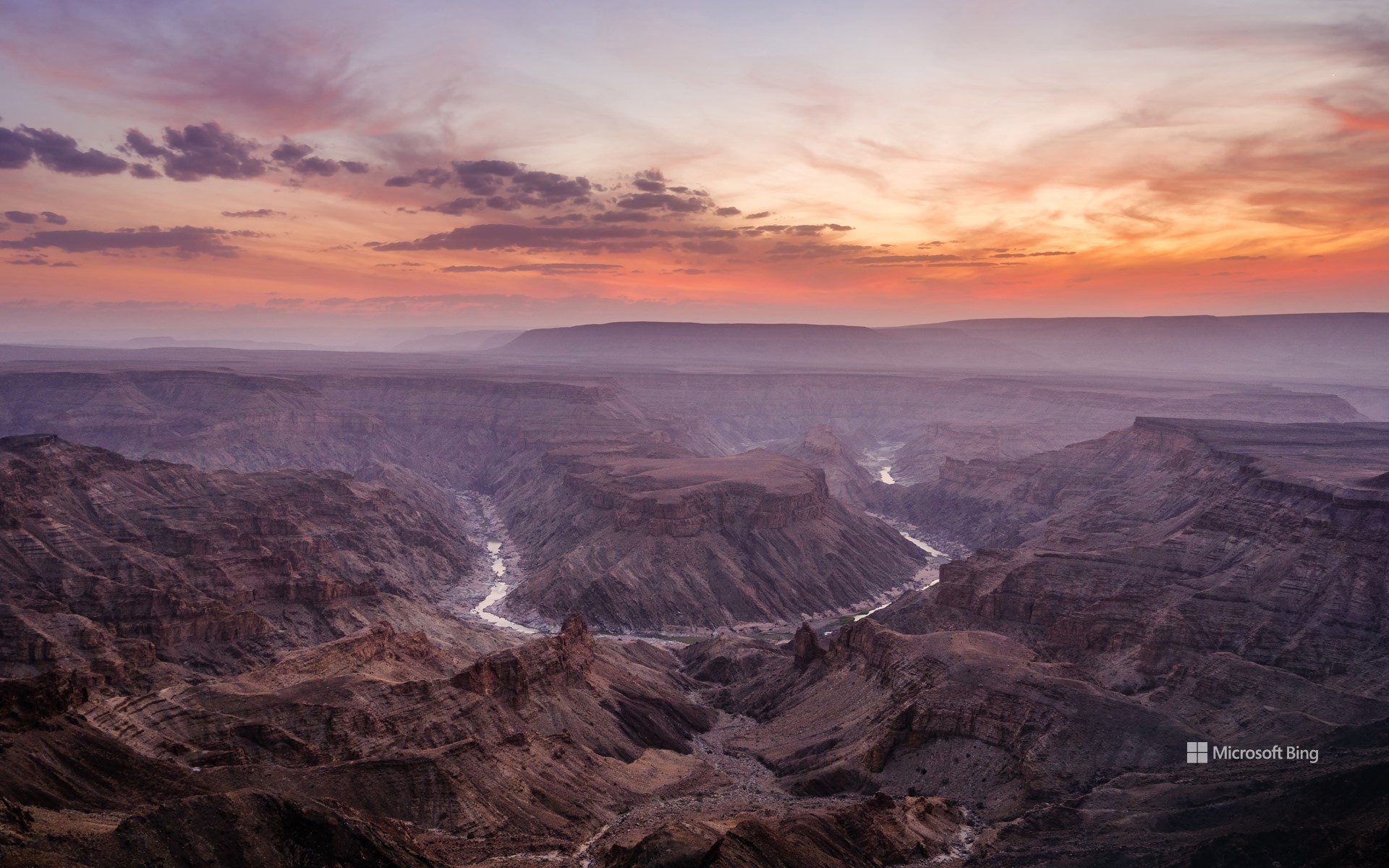
鱼河大峡谷,纳米比亚 Fish River Canyon, Namibia (© R. M. Nunes/Getty Images)
鱼眼视角 A fisheye view
鱼河大峡谷,纳米比亚
从世界上最古老的沙漠——纳米布沙漠,到奇妙的箭袋树森林,南非的纳米比亚拥有许多宝藏旅游景点。该国家最长的河流——鱼河,在数百万年的时间里侵蚀出了欧洲大陆最大的峡谷:鱼河大峡谷,它长约100英里,深约1800英尺,蜿蜒曲折,穿过风化的片麻岩层和白云岩。作为纳米比亚的热门景点之一,鱼河大峡谷以其长达50多英里的徒步小径和“鱼河峡谷超级马拉松比赛”吸引了无数探险者。此外,峡谷里还生活着哈特曼山斑马、山羚、东部岩象鼩等大大小小的生物。无论您是来轻徒步、远足、露营或者只是欣赏美景,鱼河大峡谷一定会让您终身难忘的。
Fish River Canyon, Namibia
The longest river in Namibia—the Fish River—has carved out Africa's largest canyon over millions of years. Winding through weathered layers of gneiss and dolomite rocks, the Fish River Canyon is around 100 miles long and about 1,800 feet deep. Its hiking trail stretches for more than 50 miles, attracting adventure seekers and ultramarathon runners. Moreover, with Hartmann's mountain zebras, klipspringers, and eastern rock elephant shrews, the canyon is teeming with creatures big and small. So, whether you are there for hiking, trekking, camping, or just soaking in the scenery, one thing's for sure: Fish River Canyon is a catch you won't soon forget.
沙丘中的南非剑羚,纳米比亚 Gemsbok (Oryx gazella) in sand dunes, Namibia (© Sergey Gorshkov/Alamy)
沙丘中的南非剑羚,纳米比亚 Gemsbok (Oryx gazella) in sand dunes, Namibia (© Sergey Gorshkov/Alamy)
被沙海包围 Surrounded by a sea of sand
纳米比亚沙丘上的南非剑羚
“生命总会找到出路。”虽然《侏罗纪公园》中的马尔科姆博士是在谈论恐龙繁殖,但这句话也适用于生命如何在地球上最恶劣的环境中存活。极端生物是一种可以生活在极端环境下的生物,包括高温、低温或其他超出生命所能适应的条件。例如,在寒冷的北极地区,企鹅和北极熊可以生存;在炎热的沙漠中,骆驼可以不喝一滴水存活几个月;在高酸高温高压的海洋环境中,海洋微生物依然可以茁壮成长。
Gemsbok in Namibian sand dunes
To quote Jurassic Park's Dr. Malcolm: 'Life, uh, finds a way.' Animals and plants are found in some of Earth's most inhospitable places, from penguins and polar bears in the freezing Arctic to camels in scalding deserts. This lonely gemsbok, seen here in sand dunes in Namibia, is used to living in an inhospitable environment. Also known as the oryx, it is native to the arid regions of Southern Africa, especially around the Namib and Kalahari deserts. The gemsbok does not need to drink much water, instead finding hydration in the vegetation it grazes upon—including wild tsamma melons and cucumbers. When vegetation is sparse, they can dig deep to find roots and tubers to supplement their diet.
纳米比亚的植物 Quiver trees in Namibia (© Fotofeeling/DEEPOL by plainpicture)
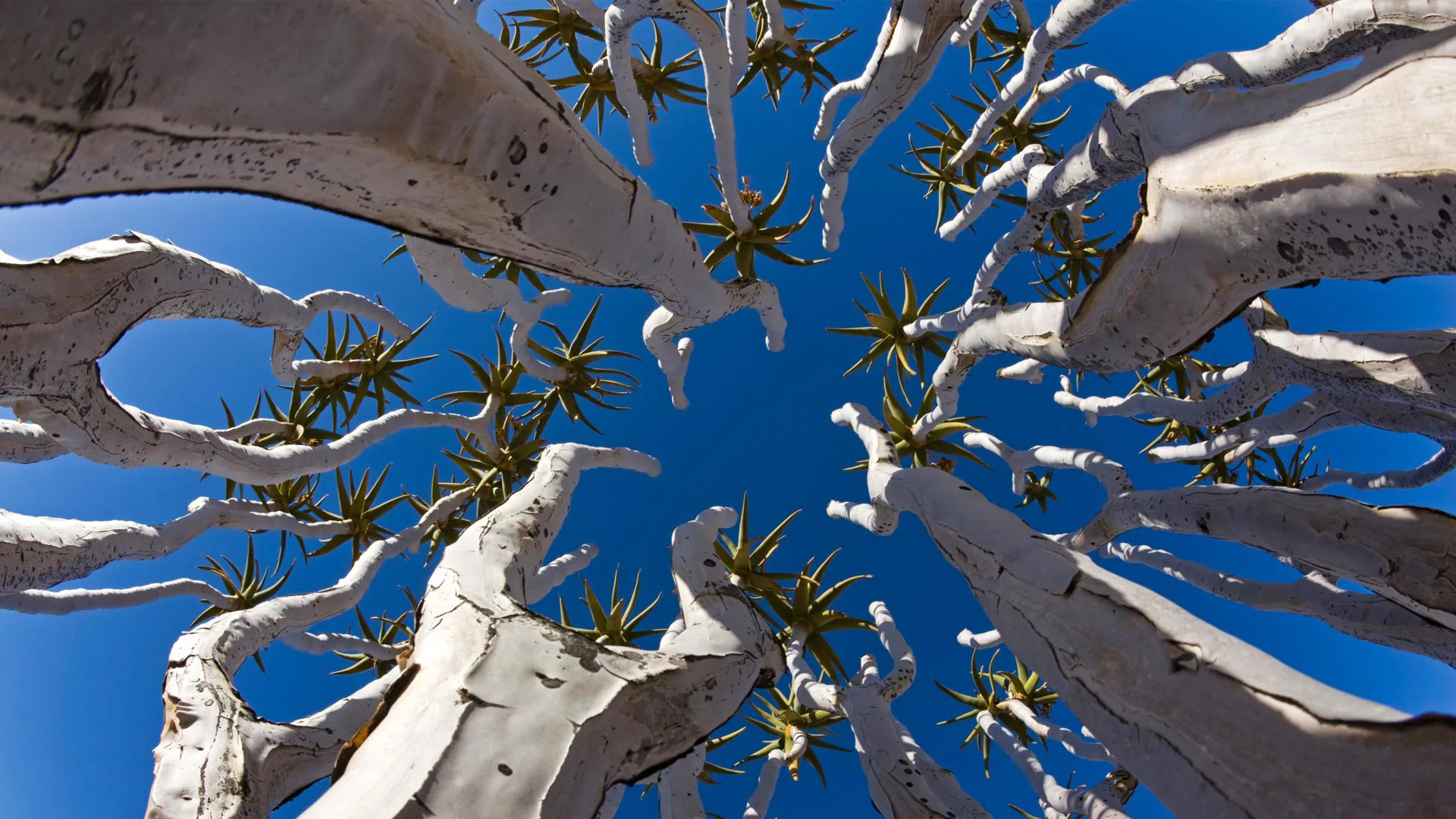
纳米比亚的植物 Quiver trees in Namibia (© Fotofeeling/DEEPOL by plainpicture)
伸向天空 Stretching to the sky
纳米比亚的箭袋树
箭袋树是一种罕见的植物,生长于气候恶劣干旱的纳米比亚。有趣的是,箭袋树其实根本不是树,而是一种高度濒危的芦荟植物,属于多肉植物。当地土著桑人会将箭袋树的枝干掏空,做成箭袋在狩猎时使用,故名箭袋树。如果你在纳米比亚的冬季(5月到7月)参观箭袋树森林,就能欣赏到这些独特的植物开出鲜黄的花朵。
Quiver trees in Namibia
The quiver trees pictured on our homepage are uniquely suited to Namibia's hot, dry climate. They are not trees at all, but an endangered species of aloe plant. These succulents can grow up to 30 feet tall and live for 200 years. The name comes from the Indigenous San people who made quivers out of the plant's tube-shaped branches to hold their arrows while hunting. You can see scattered quiver trees across southern Namibia, but for sheer numbers, head to the Quiver Tree Forest, where more than 200 of these distinctive plants grow among dolerite rock formations outside the city of Keetmanshoop. In June and July, during Namibia's winter, you can see the plant's flowers in bright, yellow bloom.
